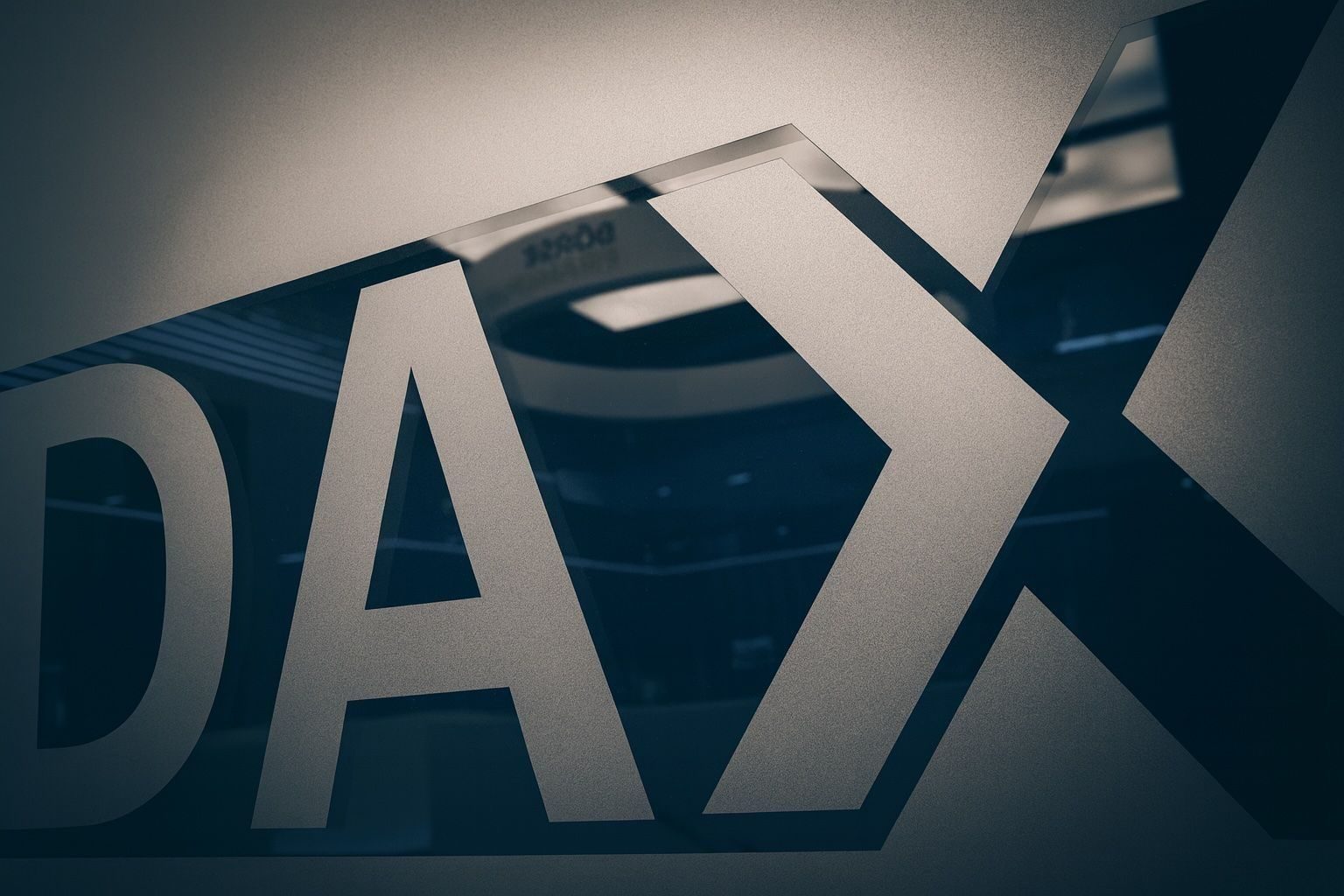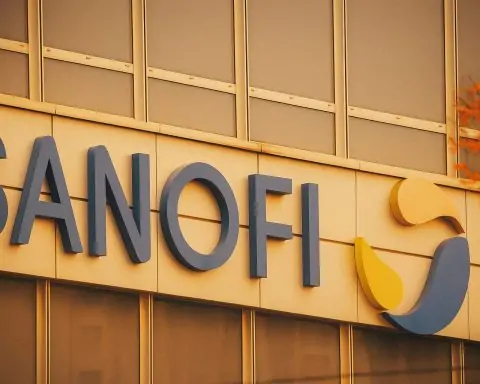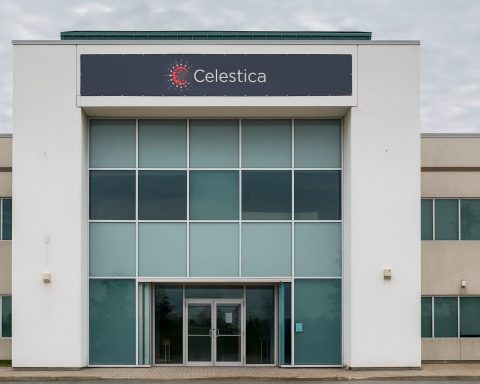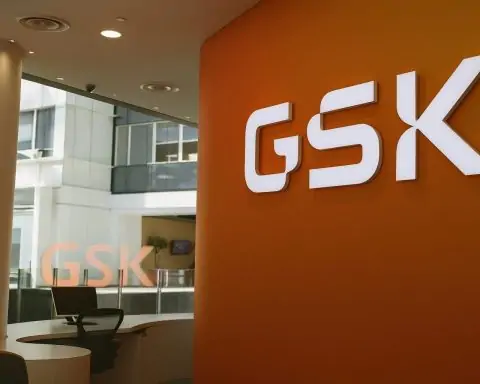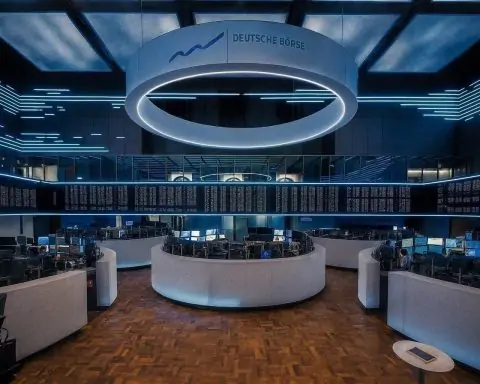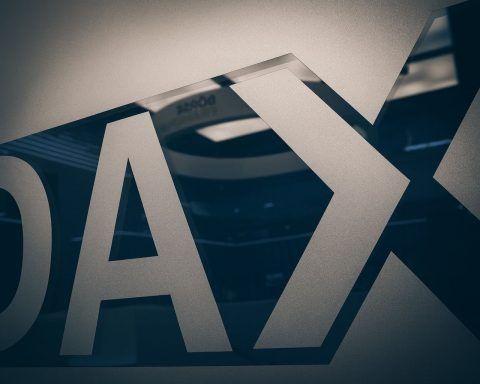Germany’s stock market started the new week with a relief rally on Monday, 24 November 2025. The DAX 40 clawed back part of last week’s heavy losses as investors cheered a double‑digit surge in Bayer shares and looked past another weak reading on German business sentiment.
By mid‑afternoon in Frankfurt, the DAX was trading around 23,200 points, up roughly 0.5–0.7% on the day, after briefly moving above 23,300 earlier in the session. [1] Medium‑sized and technology stocks joined the move: the MDAX, TecDAX and SDAX were all comfortably in positive territory, helped by broad gains across European markets. [2]
The rebound followed the DAX’s worst week in months, when the index dropped roughly 3.5% and briefly hit a five‑month low amid a global tech sell‑off and anxiety over stretched valuations. [3]
At the center of Monday’s action was Bayer, whose stock jumped around 10–12% after the company reported strong Phase III results for its experimental stroke‑prevention drug asundexian. [4]
DAX reclaims 23,200 after last week’s slide
After sliding to a multi‑month low last week, the German blue‑chip index staged a broad rebound:
- Opening level: The DAX opened Monday’s session near 23,280 points, about 1% higher than Friday’s close, mirroring Friday’s late rally on Wall Street. [5]
- Intraday range: Prices swung between roughly 23,150 and 23,400, with buyers stepping back in whenever the index approached last week’s lows. [6]
- Latest snapshot (mid‑afternoon):
- DAX: 23,213.41, +123.03 points versus Friday (about +0.5%).
- MDAX: 28,559.84, +299.88 points.
- TecDAX: 3,447.95, +39.31 points.
- SDAX: 15,979.87, +233.31 points. [7]
Early in the European session, the pan‑European STOXX 600 rose around 0.4–0.6%, with Germany’s DAX among the better‑performing major indices. [8] Banking, technology, construction and auto stocks led the gains, reflecting a broader risk‑on mood.
Asian coverage of the European open also highlighted Germany’s strength: by early evening in Korea, the DAX was quoted at 23,268.36, up 0.76% compared with Friday’s close. [9]
Bayer leads the DAX after breakthrough stroke-drug data
The clear story of the day in Frankfurt was Bayer.
Asundexian Phase III success
Bayer announced positive topline results from the Phase III OCEANIC‑STROKE trial of asundexian, its once‑daily factor XIa inhibitor for secondary stroke prevention. According to the company, a 50 mg daily dose of asundexian, on top of standard antiplatelet therapy, significantly reduced the risk of ischemic stroke compared with placebo, while meeting key safety endpoints without increasing major bleeding. [10]
The data mark a major turnaround after the same drug hit a setback in an atrial‑fibrillation study in 2023. Analysts note that the new results revive confidence in Bayer’s late‑stage pipeline, which is strategically important as older blockbusters face patent pressure. [11]
Stock market reaction
Markets reacted swiftly:
- Bayer shares surged roughly 10–12%, making the stock the top performer in both the DAX and the STOXX 600 on Monday. [12]
- Some outlets reported Bayer hitting a year‑to‑date high, fueled by renewed optimism around its pharma division. [13]
Commentators pointed out that such a large single‑stock move is notable in today’s macro‑driven market, where indices are often dominated by interest‑rate expectations rather than company‑specific stories. [14]
Because Bayer carries significant weight in the DAX, its spike added meaningful index points on its own, helping blunt the impact of weakness in other cyclical names.
Defence stocks slide as Ukraine peace talks progress
While healthcare was the standout winner, defence stocks moved sharply in the opposite direction.
- The European defence sector fell about 1–1.5%, extending losses from late last week. [15]
- In Germany, Renk, Rheinmetall and Hensoldt were among the biggest losers, each dropping around 3–4%intraday. [16]
The pressure followed reports that the United States and Ukraine are working on a “refined” peace plan to end the war with Russia, raising hopes of a diplomatic breakthrough. [17]
After an extended rally driven by rising defence budgets and geopolitical tensions, these companies are particularly sensitive to any sign of de‑escalation. Monday’s sell‑off likely reflects a mix of profit‑taking and investors repricing long‑term growth expectations if military spending normalises.
Ifo business climate dips again — but equities shrug it off
On the macro side, the main domestic data point was the Ifo business climate index, which came in weaker than expected:
- November Ifo business climate: 88.1, down from 88.4 in October and below the consensus forecast of 88.5. [18]
- There was a broad decline across sectors—industry, trade and construction—while services showed a small improvement. [19]
Ifo President Clemens Fuest said companies have “little faith that a recovery is coming anytime soon,” and economists noted that after several months of choppy readings, there is no clear upward trend in sentiment. [20]
Germany’s economy has endured two consecutive years of contraction, and forecasters expect only modest growth this year, with more meaningful acceleration pushed into 2026 as higher public investment in infrastructure and defence slowly feeds through. [21]
Despite the downbeat tone, equity investors largely looked through the weak survey on Monday:
- DAX futures stayed in positive territory after the release. [22]
- Traders instead focused on global rate‑cut hopes and the Bayer surprise, both of which were seen as more immediate drivers of prices.
In other words, the Ifo report reinforces the narrative of a still‑fragile German economy, but markets appear willing to give equities the benefit of the doubt as long as global financial conditions remain supportive.
Rate‑cut hopes and global sentiment underpin German stocks
A big reason German equities could rally in the face of soft domestic data is the shift in expectations for U.S. interest rates.
Comments from New York Fed President John Williams, suggesting another cut could be justified “in the near term,” reinforced market bets on a December U.S. rate cut. [23]
That backdrop helped risk assets globally:
- The STOXX 600 gained around 0.4–0.6%.
- Banks rose roughly 0.6%, technology stocks about 0.8%, and autos around 1.4%, with German premium carmakers such as Mercedes‑Benz and BMW among the beneficiaries. [24]
For the DAX, this environment is supportive on several fronts:
- Cyclical exporters benefit from improving risk sentiment and potentially weaker long‑term bond yields.
- Growth and tech‑linked names (like software group Nemetschek, which gained more than 4% after a fresh “buy” rating) get a valuation boost when discount‑rate expectations fall. [25]
- Utilities and infrastructure themes also gain relevance if peace prospects in Ukraine shift defence spending priorities. [26]
At the same time, analysts warn that AI‑linked valuations and global tech froth remain a risk. A widely cited market overview from Investing.com flagged the possibility that another wobble in AI stocks could quickly reignite volatility in indices like the DAX. [27]
Mid‑ and small‑caps: MDAX, TecDAX and SDAX join the bounce
The recovery was not limited to large caps. According to Deutsche Börse’s afternoon index readings: [28]
- The MDAX, which tracks medium‑sized German companies, rose by nearly 300 points to around 28,560, a gain of roughly 1%.
- The tech‑focused TecDAX advanced to about 3,448, adding more than 39 points.
- The SDAX, covering smaller companies, climbed by over 230 points to just under 15,980.
This broad participation suggests some short‑covering and renewed risk appetite beyond the mega‑caps. However, volumes remained below their three‑month average on the DAX, hinting that institutional investors may still be cautious after recent volatility. [29]
Share buybacks in focus: BASF, Deutsche Börse, All for One Group, Deutsche Post
Away from index moves, share‑repurchase programmes were a recurring theme in Monday’s German corporate news flow.
BASF: €1.5 billion buyback gets underway
Chemical giant BASF is in the early stages of a new share buyback programme of up to €1.5 billion, set to run from November 2025 until June 2026. The initiative is part of a broader €4 billion capital‑return plan extending through the end of 2028, with repurchased shares to be cancelled. [30]
While Monday’s trading update from BASF mainly reiterated the framework rather than announcing dramatic new purchases, the programme adds a steady source of demand for the stock at a time when the chemicals sector is still working through weak global industrial demand.
Deutsche Börse: ongoing 2025 buyback
Exchange operator Deutsche Börse AG published a fresh regulatory announcement detailing progress in its €500 million 2025 share buyback programme.
In the week from 17 to 21 November, the company repurchased 52,379 shares on the market, under authorisation granted at its 2024 AGM. [31]
The statement underscores management’s confidence in the group’s long‑term strategy and provides an incremental tailwind for the Deutsche Börse share, which is itself a key component of German equity indices.
All for One Group SE: mid‑cap tech buyback
In the mid‑cap space, All for One Group SE — an SAP‑focused IT services provider — released its 20th interim reporton an ongoing 2025 share buyback.
Between 17 and 21 November, the company bought back 4,578 shares at volume‑weighted average prices between roughly €38.40 and €40.54, bringing total repurchases under the 2025 programme to 38,418 shares since July. [32]
Purchases are being executed via a mandated bank on Xetra, demonstrating how even smaller German tech firms are using buybacks as a capital‑allocation tool while valuations remain below earlier peaks.
Deutsche Post (DHL Group): pause in additional buyback
Logistics heavyweight Deutsche Post AG (DHL Group) also published an update on its additional share buyback programme. Interestingly, the company reported that no shares were repurchased between 17 and 21 November under this specific mandate, though earlier tranches remain in place. [33]
Analysts will watch whether this pause reflects tactical timing, regulatory considerations, or shifting capital priorities as the group weighs investment needs against shareholder returns.
Key takeaways for investors
Putting Monday’s moves together, several themes stand out for anyone following the German stock market:
- Relief, not euphoria
- The DAX’s rebound above 23,200 is meaningful but not decisive after last week’s ~3.5% slide and five‑month low. The index is still well below its recent 24,000+ highs. [34]
- Stock‑specific catalysts still matter
- Bayer’s double‑digit jump shows that strong clinical data can still drive outsized returns, even in a macro‑dominated environment. For active investors, stock selection remains crucial. [35]
- Geopolitical developments cut both ways
- Progress toward a Ukraine peace plan is negative for defence stocks but positive for broader risk sentiment, potentially shifting leadership from arms manufacturers toward infrastructure and cyclicals over time. [36]
- German macro is still fragile
- The weaker‑than‑expected Ifo reading underscores that domestic growth remains subdued, even as markets price in better times ahead thanks to future fiscal stimulus and lower global rates. [37]
- Buybacks quietly support valuations
- From BASF and Deutsche Börse to mid‑cap names like All for One, repurchase programmes are providing a structural bid for German equities and signalling management confidence. [38]
What to watch next
Looking ahead, traders in Frankfurt will be focused on:
- Upcoming U.S. economic data and whether they reinforce or challenge expectations for a December Fed rate cut. [39]
- The British budget later this week, which could influence European risk sentiment and bond yields. [40]
- Any further details on the Ukraine peace talks, which could prolong the rotation out of defence stocks. [41]
- Follow‑up analysis and, eventually, full peer‑reviewed data on Bayer’s asundexian, which will determine whether Monday’s optimism is sustained. [42]
For now, 24 November 2025 will go down as a day when the German stock market finally caught its breath, with Bayer’s drug breakthrough and global rate‑cut hopes outweighing another reminder that Europe’s largest economy is not out of the woods yet.
This article is for informational purposes only and does not constitute investment advice. Always conduct your own research or consult a professional adviser before making investment decisions.
References
1. www.cashmarket.deutsche-boerse.com, 2. www.cashmarket.deutsche-boerse.com, 3. www.marketscreener.com, 4. www.reuters.com, 5. www.marketscreener.com, 6. www.investing.com, 7. www.cashmarket.deutsche-boerse.com, 8. www.reuters.com, 9. cm.asiae.co.kr, 10. www.bayer.com, 11. kfgo.com, 12. www.reuters.com, 13. www.marketscreener.com, 14. uk.investing.com, 15. www.reuters.com, 16. www.reuters.com, 17. www.reuters.com, 18. www.reuters.com, 19. www.reuters.com, 20. www.reuters.com, 21. www.reuters.com, 22. www.finanzen.ch, 23. www.reuters.com, 24. www.reuters.com, 25. www.reuters.com, 26. www.marketscreener.com, 27. uk.investing.com, 28. www.cashmarket.deutsche-boerse.com, 29. www.investing.com, 30. www.basf.com, 31. www.deutsche-boerse.com, 32. www.tradingview.com, 33. www.ad-hoc-news.de, 34. www.marketscreener.com, 35. www.bayer.com, 36. www.reuters.com, 37. www.reuters.com, 38. www.basf.com, 39. www.reuters.com, 40. www.reuters.com, 41. www.reuters.com, 42. www.bayer.com
